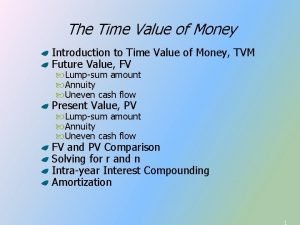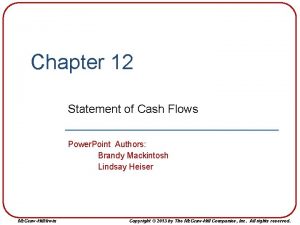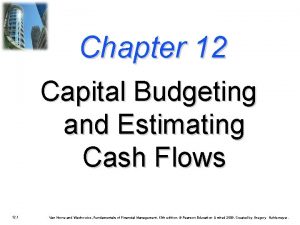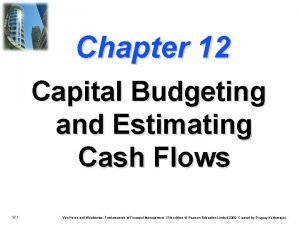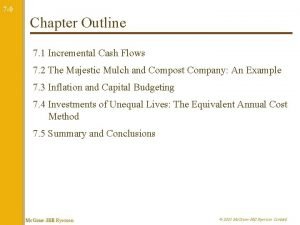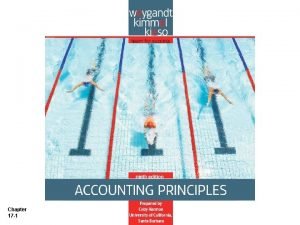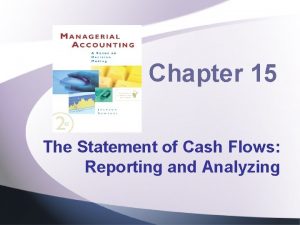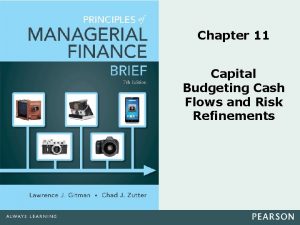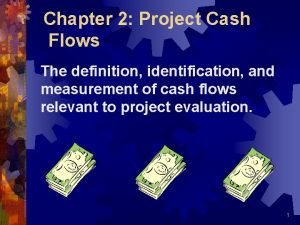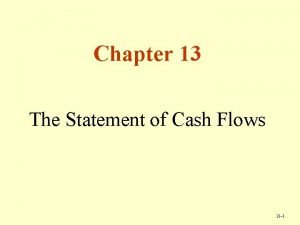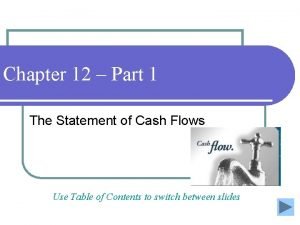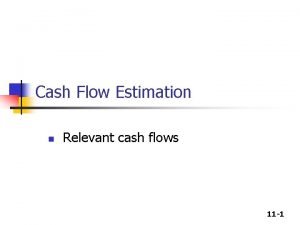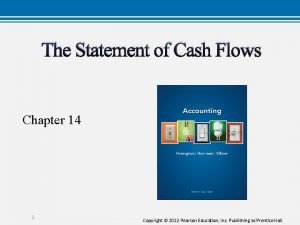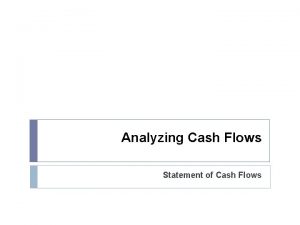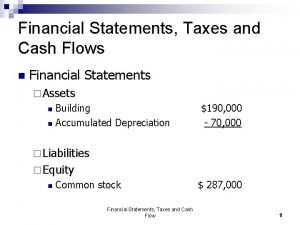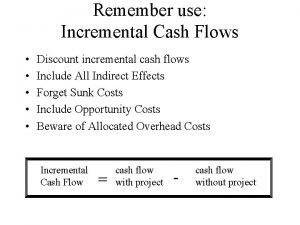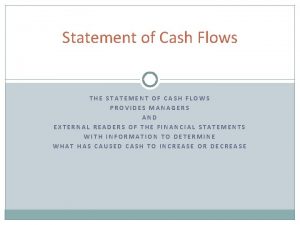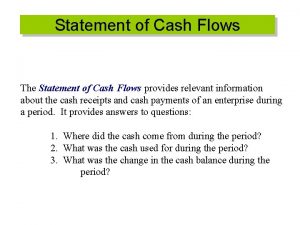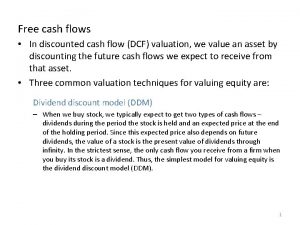Session 19 Cash Flows The Perfect Storm Financial

























- Slides: 25

Session 19 Cash Flows, The Perfect Storm & Financial Statement Analysis FINANCIAL ACCOUNTING - BUS 020 - SPRING 2015

Businesses are like Fruit Trees Fruit = Operating Activities Trunk & Branches = Investing Activities Roots = Financing Activities FINANCIAL ACCOUNTING - BUS 020 - SPRING 2015

Statement of Cash Flows n Operating n n n Investing n n Working capital, day-to-day transactions Direct versus indirect methods Non-current assets—mainly PP&E and marketable securities Financing n Debt, equity and dividends paid FINANCIAL ACCOUNTING - BUS 020 - SPRING 2015

Accounting’s Perfect Storm n n IFRS Adoption Convergence Completion n n Including Financial Statement Reformating Private Company Financial Reporting n n PCC FRF FINANCIAL ACCOUNTING - BUS 020 - SPRING 2015

Target Your Efforts n Solvency assurance n Wealth enhancement n Performance improvement FINANCIAL ACCOUNTING - BUS 020 - SPRING 2015

Start with the 3 P’s n Planning n Processing n Presenting FINANCIAL ACCOUNTING - BUS 020 - SPRING 2015

Include the Trifecta: Q-S-T n Q: Quantitative analysis n S: Strategic assessment n T: Tactical feasibility FINANCIAL ACCOUNTING - BUS 020 - SPRING 2015

Tools for Financial Statement Analysis n n n Ratio analysis Trend analysis Common-size analysis Base period analysis Comparative analysis Horizontal and vertical analyses FINANCIAL ACCOUNTING - BUS 020 - SPRING 2015

A Financial Statement Approach n n n Look for key relationships Focus on spending drivers Don’t overlook the Statement of Cash Flows Remember to measure trends Tell a story FINANCIAL ACCOUNTING - BUS 020 - SPRING 2015

Guidelines for a Presentation n n Clarity Accuracy Simplicity Visually friendly Limit page content FINANCIAL ACCOUNTING - BUS 020 - SPRING 2015

Cash Flow Red-Flags n n Receivable and inventory growth rate exceeds sales growth rate Payables growth rate exceeds inventory growth rate Current liabilities grow faster than sales Sustained operating losses (negative net income) FINANCIAL ACCOUNTING - BUS 020 - SPRING 2015

Cash Flow Red-Flags n n n (cont’d) Negative operating cash flow Capital expenditures exceed operating cash flow Sustained capital expenditures reductions Sustained sales of marketable securities in excess of purchases Substantial shift from long to short term borrowing Dividend reduction or elimination FINANCIAL ACCOUNTING - BUS 020 - SPRING 2015

Cash Sufficiency Ratio n n Cash Flow From Operations + Interest + Taxes PPE + Debt Servicing + Taxes + Dividends Should be greater than 1 Can easily disaggregate Different footprints for different development stages FINANCIAL ACCOUNTING - BUS 020 - SPRING 2015

Cash Conversion Cycle n Cash conversion cycle n Days in payables ≥ DSO + Days in inventory FINANCIAL ACCOUNTING - BUS 020 - SPRING 2015

Typical Common Ratios n n n Solvency & liquidity Earnings Performance FINANCIAL ACCOUNTING - BUS 020 - SPRING 2015

Ratio Analysis n General guidelines: n n n Be consistent Ascertain contents of numerator and denominator Apply common sense… FINANCIAL ACCOUNTING - BUS 020 - SPRING 2015

Trend Analysis n n n Static analysis is virtually useless Trend direction is key Combine with other approaches FINANCIAL ACCOUNTING - BUS 020 - SPRING 2015

Common-size Analysis n n n Helpful for size discrepancies Keyed to sales or total assets Helpful for industry comparisons FINANCIAL ACCOUNTING - BUS 020 - SPRING 2015

Base Period Analysis n n Combines trending and percentage analysis Select representative base year and set the index at 100 Measure subsequent periods in terms of the base year Helpful for industry comparisons n Eliminates size bias FINANCIAL ACCOUNTING - BUS 020 - SPRING 2015

Comparative Analysis Cautions n n n Timing variances GAAP variances Conservative vs. Aggressive GAAP Management attitude…”win at all cost!” Size Geographic venues FINANCIAL ACCOUNTING - BUS 020 - SPRING 2015

Horizontal and Vertical Analysis n n n The most basic…and most powerful analytical tool Key element in fraud detection Keeps the organization under control FINANCIAL ACCOUNTING - BUS 020 - SPRING 2015

Horizontal Analysis n Period versus period changes Value changes n Percentage changes n n Look for irregularities FINANCIAL ACCOUNTING - BUS 020 - SPRING 2015

Horizontal Analysis Example FINANCIAL ACCOUNTING - BUS 020 - SPRING 2015

Vertical Analysis n Relationships within the same period: Numerical relationships n Percentage relationships n n Look for irregularities FINANCIAL ACCOUNTING - BUS 020 - SPRING 2015

Vertical Analysis - Example FINANCIAL ACCOUNTING - BUS 020 - SPRING 2015
 The cash budget shows anticipated cash flows
The cash budget shows anticipated cash flows Pv of cash flows formula
Pv of cash flows formula Incremental cash flow
Incremental cash flow Payback period uneven cash flows
Payback period uneven cash flows Cash flow indirect method
Cash flow indirect method Incremental cash flows
Incremental cash flows Incremental cash flow
Incremental cash flow Working capital investment example
Working capital investment example Iatcf
Iatcf Partial statement of cash flows
Partial statement of cash flows Operating investing and financing activities
Operating investing and financing activities Cash flow pro
Cash flow pro Prepaid expenses in cash flow statement
Prepaid expenses in cash flow statement The statement of cash flows reports
The statement of cash flows reports Chapter 11 capital budgeting cash flows solutions
Chapter 11 capital budgeting cash flows solutions Taxes payable cash flow statement
Taxes payable cash flow statement Granting credit letter
Granting credit letter Chapter 23 statement of cash flows
Chapter 23 statement of cash flows Relevant cash flows definition
Relevant cash flows definition The statement of cash flows classifies items as
The statement of cash flows classifies items as Chapter 13 statement of cash flows
Chapter 13 statement of cash flows Flow chapter 13
Flow chapter 13 The statement of cash flows helps users
The statement of cash flows helps users Relevant cash flows
Relevant cash flows Destiny corporation is preparing its
Destiny corporation is preparing its Relevant cash flow
Relevant cash flow

